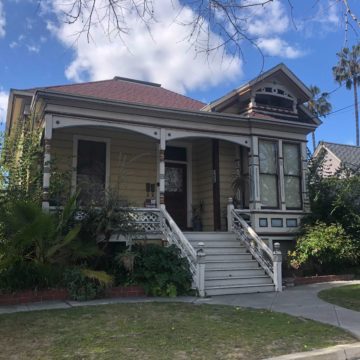California Gov. Gavin Newsom effectively did away with single-family zoning last month with two pieces of legislation. But implementing the bills is leaving San Jose officials and elected leaders with questions as the laws come closer to taking effect.
The San Jose City Council held a study session Thursday to discuss Senate Bills 9 and 10, which take effect Jan. 1. SB 9 and 10 will make it easier to build multiple units on plots of land originally zoned for single-family homes.
SB 9 allows for the development of more than one home on single-family lots, while SB 10 allows local governments to streamline the rezoning process for multi-family housing projects of up to 10 units near transit and urban areas.
Unanswered questions
The housing crisis has led San Jose to become the second most expensive place to rent in the country. Though residential development is booming, construction of affordable units isn’t. According to a San José Spotlight report, of the 15 large multi-family developments under construction in the region, only 189 of the 5,932 units are considered affordable to low-income households. The city is also far behind its goal to build 25,000 homes—10,000 of them affordable—by 2023.
San Jose’s housing department is still analyzing how exactly the city will implement SB 9 and 10, including making sure the city’s various development laws, like those regarding guest homes, will work with the state bills.
“There’s still a lot of unanswered questions,” said Martina Davis, acting division manager with the planning department.
Issues raised by councilmembers and residents include whether or not height limits are required for homes built under SB 9 and which neighborhoods will be exempt, such as historic districts or sites.
SB 9 requires that an applicant live on one of the lots they are converting for at least three years. Councilmember Pam Foley asked how the city plans to enforce the provision.
“A homeowner could say they intend to live there, but then they don’t live there,” Foley said. “I just imagine a bureaucratic nightmare in us trying to keep track of that.”
City officials said they are still studying how to enforce that provision.
An example of a possible configuration that could accommodate 10 units on a single-family home—with a mix of ADUs and duplexes—also raised concern among councilmembers.
“As much as I think it’s incredibly improbable that anyone is going to be able to reach for this 10-unit strategy and actually be able to implement it, I would certainly like to get in front of that,” said Mayor Sam Liccardo.
He asked if city officials are looking at a policy to address the extreme configuration. Staff intends to bring back a related policy in December.
With many questions still unanswered from the state, more than two dozen residents shared their concerns with the laws.
“We’ve tried to read and understand SB 9 and 10. We all agree it’s very confusing,” said resident Johnny Lang. “Why don’t we go up? The only thing this law is intended to do is cause confusion.”
The study session also looked at a similar local proposal called Opportunity Housing, which would allow developers to build duplexes, triplexes and fourplexes in single-family home neighborhoods.
Opponents believe Opportunity Housing will worsen parking, put stress on the city’s utilities and emergency services and benefit developers. Proponents say Opportunity Housing should be kept alive because it’s complementary to the state laws, but addresses San Jose’s unique housing needs.
“We’re really happy you’re working to implement Senate Bill 9 and Senate Bill 10, which we hope will create many housing opportunities for our clients and the community,” said Kylie Clark, public policy coordinator at West Valley Community Services. The organization is part of a coalition called San Jose Neighborhoods for All, which supports the construction of multi-unit housing.
Quality of life issues
Though SB 9 and 10 are meant to put a dent in the state’s housing crisis, a recent study by the Terner Center for Housing Innovation at UC Berkeley estimated that just 5.4% of California’s current single-family lots have the potential to be developed under SB 9—paving the way for 714,000 new homes. That’s far short of the 3.5 million new residences Newsom wants to see built by 2025.
The study also says that of 331,000 single-family homes in Santa Clara County, only 30,500 could be converted into new units.
Some residents fear that more housing will lower property values and take away the opportunity for families to invest in single-family homes.
“There are many, many issues around infrastructure and quality of life,” said District 10 resident Carl Fussell. “This is going to be forced on us whether we think it’s a good idea or not. Please think this (through) and do it right because SB 9 isn’t it.”
Opponents believe cutting red tape for housing developers and developing near transit hubs will help with the city’s housing crisis.
“How do we track the impact of providing services and mitigate that impact?” said Councilmember Matt Mahan.
Some councilmembers have taken stances against measures like SB 9 and 10 and building multiple units in neighborhoods with single-family homes. In August, Mahan rejected Opportunity Housing and presented his own plan to develop near transit hubs.
City officials plan to come back with an update on their work in December.
“This does not conclude the conversation on this topic, which I expect to be robust over the next few weeks,” Liccardo said.





